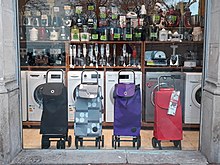Shopping bag
Appearance



Shopping bagsare medium-sized bags, typically around 10–20litres(2.5–5 gallons) involume(though much larger versions exist, especially for non-groceryshopping), that are used by shoppers to carry home their purchases. Some are intended as single-usedisposable products,though people may reuse them for storage or asbin liners,etc.; others are designed asreusable shopping bags.
Types[edit]

Around the world[edit]
Types and typical use of shopping bags vary by country:
- In many European Union (E.U.) countries, single-useplastic shopping bagsare provided free by stores and have been common into the early 21st century, but their use is becoming less widespread, partly due toenvironmental legislation,which has led retailers to charge for them.[citation needed]Ireland,for example, imposed a dedicated plastic bagtax,thus forcing retailers to charge for them.[1]
- In 2008, China banned free plastic shopping bags and businesses were prohibited from manufacturing, selling, or using bags less than 0.025 millimeters (0.00098 inches) thick.[2]
- Reusable shopping bags are increasingly used, e.g. in E.U. countries where use of single-use plastic shopping bags is in decline. Reusable bags are often made fromjutecloth, also known asburlapin the U.S. Some are made of plastic, but reusable plastic bags are sturdier than single-use plastic bags. In the U.S., reusable bags are sometimes used as a fashion statement or for advertising.[3]
- In the United States and Canada, single-use plastic bags are commonly provided free with a shop purchase in many localities. Some retailers, such as department stores, are more likely to provide paper bags to shoppers, whereassupermarketsandgrocery storestend to give plastic shopping bags. People are encouraged to have reusable shopping bags, whenever possible; in some municipalities (Chicago, for example) they must pay a government-mandated fee if they use plastic shopping bags. Some municipalities charge a tax for paper shopping bags.
- California banned disposable bags. All local jurisdictions in Hawaii banned plastic bags.
- In an effort to reduce plastic bag use, the city ofToronto,Canada, required retailers to charge a minimumCA$0.05fee for each plastic bag. Toronto has since banned disposable bags. Prompted by the plastic bag charge in Toronto, many national retailers have imposed similar fees on plastic bags in their outlets in other parts of Canada. All of the profits derived from the $0.05 fee go directly to the retailer.[4][5]
- In Canada, Toronto and Montreal have banned plastic bags.
See also[edit]
References[edit]
- ^"Irish bag tax hailed success".BBC News.2002-08-20.Retrieved2010-05-23.
- ^"China Bans Free Plastic Bags".Associated Press. 2008-01-10. Archived fromthe originalon January 16, 2008.Retrieved7 July2018.
- ^Barbaro (December 16, 2007)."Never Mind Whats In Them, the Bags are Fashion".New York Times.Retrieved2007-12-16.
- ^"Toronto's new plastic retail shopping bag bylaw now in effect".City of Toronto. 2009-06-01. Archived fromthe originalon 2009-06-07.Retrieved2009-06-09.
- ^"Retailers can keep fees for plastic bags".National Post.2009-06-02.Retrieved2009-06-09.[permanent dead link]
